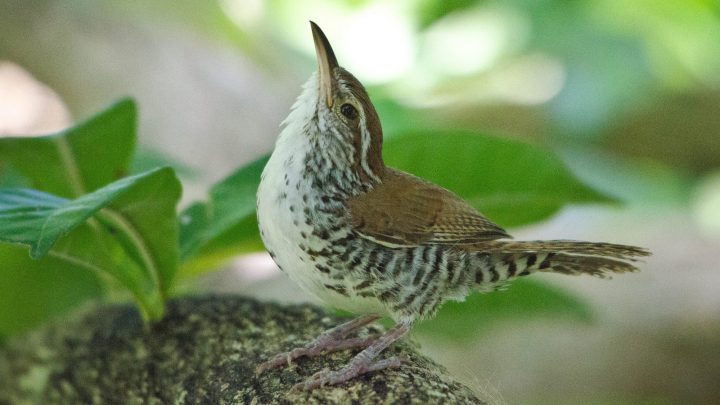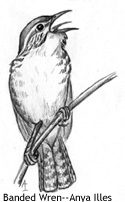Sounding Out the Dawn Chorus of Banded Wrens in Costa Rica
By Miyoko Chu and Kristin Sargianis
July 6, 2015
The dawn chorus is one of the most conspicuous vocal behaviors of birds, and one of the least understood. Near sunrise, birds often sing more loudly and vigorously than they do at other times of the day. Recent studies have suggested that these intense bouts of song may help male birds exchange information about their social standing. However, because so many birds sing at once, sorting out these vocal interactions has been difficult using traditional techniques such as observation and simple audio recordings.

Taking a new approach, Cornell Lab researchers John Burt and Sandra Vehrencamp used microphone arrays at a field site in Costa Rica to record the dawn chorus from 13 locations simultaneously on the territories of 4 male Banded Wrens. Using software and techniques developed by the Lab’s Bioacoustics Research Program staff, they later pinpointed the locations of singing wrens based on how long it took the sound to travel to different microphones. Song by song, they analyzed spectrograms of the wrens’ vocalizations.
They found that many Banded Wrens were alternately directing their songs to specific neighbors and responding to one another—the first evidence that birds communicate in a networklike fashion during the dawn chorus. The results were published in Animal Communication Networks (Cambridge University Press).
Banded Wrens are tropical relatives of Carolina Wrens that inhabit deciduous forests along the Pacific slope of Central America. During the dawn chorus, males perch high in trees and sing an assortment of songs based on a repertoire of 15 to 30 song types. Previous work by Vehrencamp and Laura Molles, a former graduate student, showed that in territorial disputes, a male signals his aggressive intentions by singing the same song type as his neighbor. He switches to a non-shared song type if he wants to back down.

“In the field, we could hear Banded Wrens matching one another’s songs,” Vehrencamp said. “Sometimes we could hear song types rippling through the population.” The analyses confirmed high rates of song matching, suggesting that competitive interactions are particularly intense during the dawn chorus. Furthermore, males used different song types to match different neighbors in rapid succession, evidence that they were communicating in a network, rather than broadcasting songs indiscriminately.
The dawn chorus is a complex phenomenon, and most likely it functions in more than one way, not just in social signaling. Burt and Vehrencamp’s contribution is twofold. They’ve shown that Banded Wrens listen and respond to one another, sending out purposeful and dynamic messages to multiple neighbors. And in the process of recording and transcribing the chorus, the researchers have introduced some innovative techniques that can be used to gain further insights about why birds sing at dawn.
This article was originally published in the Spring 2004 issue of BirdScope.

All About Birds
is a free resource
Available for everyone,
funded by donors like you
American Kestrel by Blair Dudeck / Macaulay Library
